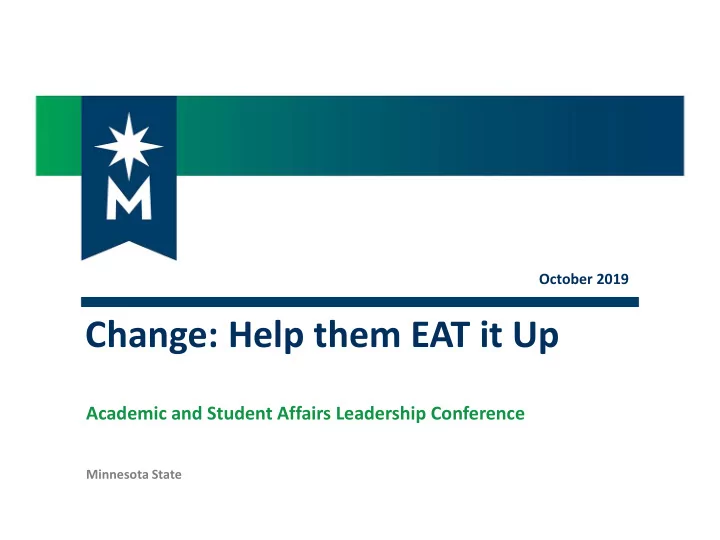

October 2019 Change: Help them EAT it Up Academic and Student Affairs Leadership Conference Minnesota State
Objectives • Help employees (and ourselves) deal with the emotions generated by change. • Take action to deal with the most important issues. • Communicate with others about the change.
Change – EAT it up! Step 1: Deal with Emotions Step 2: Help Them Take Action Step 3: Talk to Them About the Change
Step 1: Deal with Emotions
Reacting to Change Primary goal: Create Safety • Our brains evolved to focus on threats. • Social threats are as significant as physical threats • When we feel threatened, our brains close down, options narrow to flight or flight. • When we feel safe, we are able to consider options, plan, make better decisions.
William Bridges – Transition Model
What Could be Ending? Creative Commons 4.0 BY-NC
Helping people through the transition • As leaders, disagree behind closed doors. • Don’t immediately try to “fix” things. • Assess where people are in dealing with the change and acknowledge their feelings. • Be clear about what is changing and what is staying the same.
What about my emotions? • What is changing for me as a leader? • What am I worried about? • What do I need in order to move forward?
Step 2: Help Them Take Action • Clarify roles and responsibilities. • Work together on an action plan to be sure the critical work continues to get done. • Provide training, time to practice new skills, and a safe space to experiment.
Step 3: Talk to Them About the Change • Identify key stakeholders. • Create a communication plan. – Provide context to help them understand why the change happened. – Help them understand their role. • Listen!
Who is a Stakeholder? Stakeholder: An individual, group, or organization who may affect, be affected by, or perceive itself to be affected by a decision, activity, or outcome of a project, program, or portfolio (PMI,2015).
Engaging Stakeholders • Give an example of a time when a change effort was successful in engaging stakeholders. • Give an example of a time when a change effort was NOT successful in engaging stakeholders.
Identifying Stakeholders • Brainstorming – who will be affected by the change or play a role in implementation? • Questions to consider: • Who cares about this change? Why? • Who will be impacted by the change? • Who will do the work? • Whose resources will fund and/or staff the effort? • Whose approval is necessary? • Who should not be surprised?
Engaging Stakeholders Vision & Action Communication Resources • Clear purpose • Two-way: • Information and plan listen and act • Training • Effectively • Informal and • Support meeting formal objectives • Regular and consistent
Stakeholder Matrix • Identify the landscape of support and resistance. • Develop a more strategic communication plan. Influence
Communication Plan • For each key stakeholder, consider: • Key message – What do they care about? – What do you care about? • Communication methods • How will you send the message? – Remember the adage about sending a message 8 times and 8 different ways • When and how often should the messages go out? • Who is responsible for sending the messages?
Creating a Communication Plan Stakeholder What they What I need Comm. Timing Who’s need from from them method responsible me
Questions? What’s one new idea you are going to take away from this session?
30 East 7th Street, Suite 350 St. Paul, MN 55101-7804 651-201-1800 888-667-2848 www.MinnState.edu This document is available in alternative formats to individuals with disabilities. To request an alternate format, contact Human Resources at 651-201-1664. Individuals with hearing or speech disabilities may contact us via their preferred Telecommunications Relay Service. Minnesota State is an affirmative action, equal opportunity employer and educator.
Recommend
More recommend